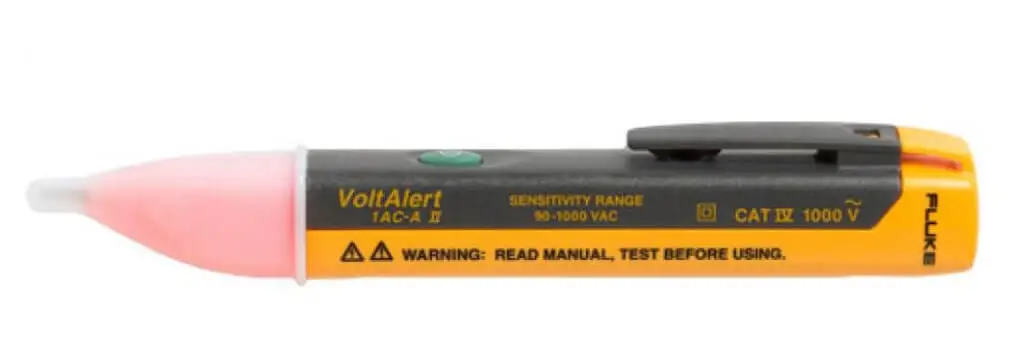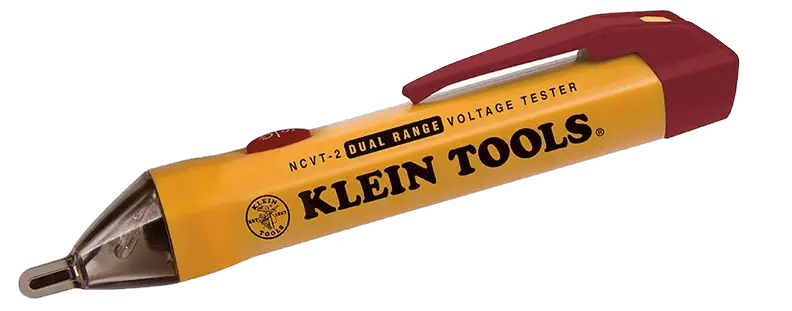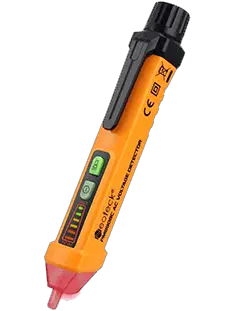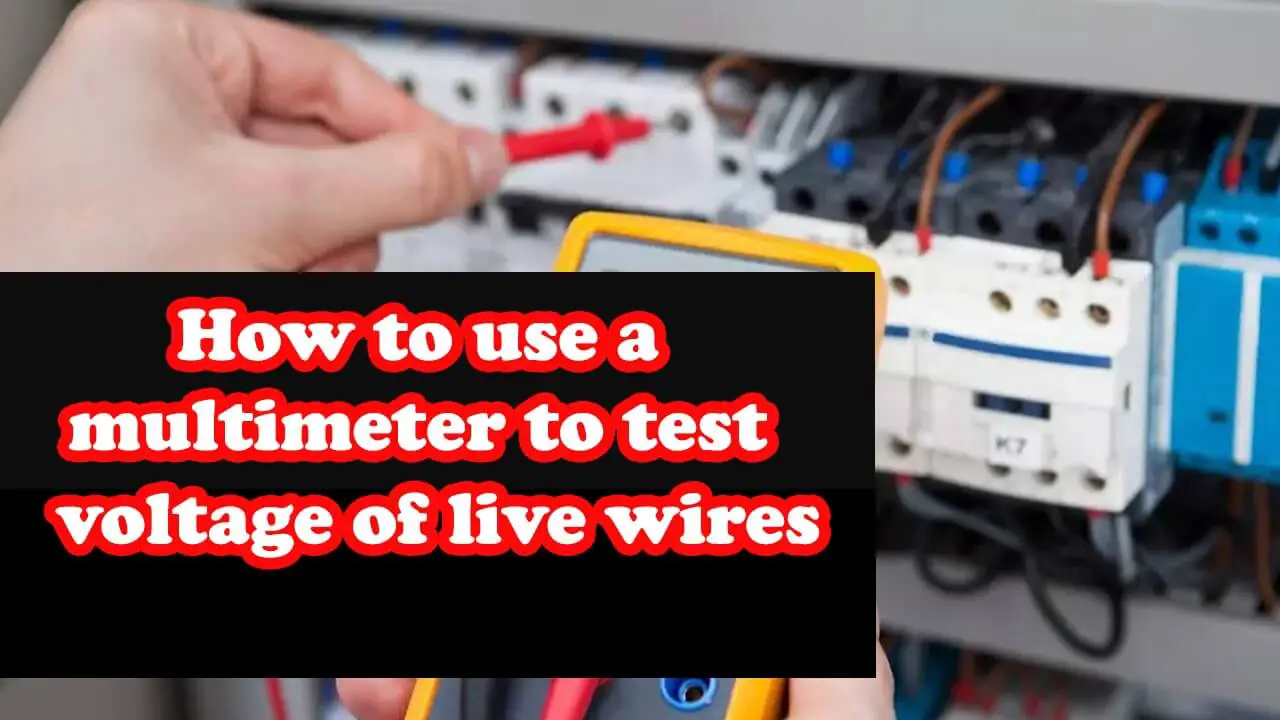Best Voltage Testers 2022 Buying Guide
A non-contact voltage tester is a device that is very easy to make the work of an electrician effortless. The device identifies a quick, reliable, and safe way to detect an electric connection that carries an electric current. Hence, we have recommended some products for workers in constant exposure to live wires even if it is configuring the household electrical appliances.
This article is beneficial in finding the best voltage tester. We have listed some of the best and most reliable non-contact electrical tester products:
Table of Contents
Top 3 Voltage Testers 2022
1. Fluke 1AC-A1-II VoltAlert Non-Contact Voltage Tester
Fluke 1AC II is an easy-to-use VoltAlert tester that you can use anywhere, and this is the perfect tool for electricians.
Voltage detection range for wide application use – 90 V to 1000 V AC or 200 V to 1000 V AC
Continuous self-test so you always know it is working
Volt stick with Audible/Silent mode for added convenience
Quick Review:
- While testing voltage, the tip of the tester glows and gives a beeper sound.
- CAT IV 1000 V protected
- Voltage Range from 90-volts to 1000-volts
- We are testing the line voltage from 90v A/C – 600v A/C (1AC-AI-II).
Key Features:
- This device is the simple way to test if a live voltage exists within an electrical circuit system.
- The tip of the tester glows red, and the detector gives an audible sound beep if the voltage is present.
- If you want to disable the beeper, press the green button and hold on for a few seconds.
- If you want to reactivate the beeper, switch the detector to the off position and turn it on again.
- The voltage ranges from 200V to 1000V A/C.
- Fluke 1AC voltage tester is accurate.
- CAT IV 1000V safety rated
Key Functions:
Simple to use, reliable and accurate as an essential part of electrical troubleshooting, the Fluke IAC II will help you quickly determine whether there is voltage present within an electrical circuit.
To start the tester, touch the tip of the IAC-II Voltage tester against a terminal, outlet or supply cord. If it glows red and starts to beep, you know there’s a live voltage on the system. Please note: disable the beeper by pressing the green start-up button for longer than two seconds; to reactivate the beeper, restart the tester. Fluke 1AC II VoltAlert Voltage Detector function need only be switched off and then switched back on again.
The Fluke IAC II can detect AC voltage from 200V to 1000V. The IAC II will also continuously test itself to ensure its accuracy, so you always know the detector is working just like it should.
This voltage tester is CAT IV 1000V safety rated and supplied as standard with Fluke’s two-year warranty.
- Simple in operations.
- Easy in handling
- Durable case
- Battery life is excellent
- An excellent voltage signal function
- It does not have a dual-range voltage test.
2. Klein Tools NCVT-2 Voltage Tester
The Klein tools NCVT II voltage tester is best for its safety operations and is known for its overall operations. It can test both types of equipment; standard voltage and also low voltage.
Quick Review NCVT-2:
- It can test standard and low voltage applications of household use.
- It Includes an infrared thermometer function.
- It can handle two ranges of voltage
- It has a battery life indicator
- It can read measurements together with an LED bar graph
- It has a dual-range testing
- Operation with blue light
- Bright LED lights
- Auto shutoff feature
Key functions NCVT-2:
The standard expectation of the voltage tester is to detect the standard and low voltage. But something is unique with this item. Klein tools NCVT II could identify the standard voltage and types of equipment with a minimum voltage supply. So it has two ranges testing the feature. This must be the best feature for electricians, that is, 12 volts-10000 volts and a 48-1000v A/C alternating current.
The battery power is of long life, while it has an auto-shutdown system to avoid unnecessary battery consumption.
Remember, it is easy to handle non-contact A/C voltage testers? To guarantee that, this Klein tools NCVT II voltage tester is lightweight with a handy clip to hang to hands-free operations.
- The polycarbonate body assures its longevity
- Lightweight device
- Accessible in handlings with equipment
- It can lighten up the working area
- Simple operations
- Detects standard voltage only
- Not suitable for operation with more than one circuit
3. Neoteck Non-Contact AC Voltage Tester Pen
Neoteck Non-Contact Voltage Tester Because of the wide measurement range (12V-1000V), if there is live equipment or static electricity nearby, an alarm will sound. Even if the measured object is not touched, the device will flash and beep when it comes within a few feet of an AC voltage that exceeds the specified voltage range.
Quick review:
- Wide range of voltage readings
- Multifunctioning
- Easy to handle
- The battery compartment is 20mm
- The strength of electromagnetic field sense CE and CAT certified
- Lightweight device
- Bright LED light
Key Functions:
Neoteck is an advanced A/C non-Contact Voltage Tester Pen. It has a wide range of detecting 12-1000Volts A/C. Therefore it can test almost all the appliances at home. This non-contact voltage tester is efficient in all functions, including its detecting power.
Therefore, it can detect both standard and minimum voltage and identify very nominal voltages. This voltage tester can also be used as an emergency led flashlight that helps work in darker environments during circuit breaks.
- It can detect the low voltage in LED lighting fixtures.
- It can be lit the working area
- LED light
- Pocket size
- This voltage tester has high sensitivity. It detects an electric field near human skin.
Types of Voltage testers
There are four types of voltage testers with different features and functions: digital multimeter, clamp meter, plug tester, and tick tracers.
As electricians, we have a lot of different testers that we use out there. And there are tons of various reasons we might have one tester over another or have some advanced and expensive test equipment versus some old ones. But, among cheaper types of equipment, there are four essential pieces of technology that you will come across. Most electricians have one or all of these four types of equipment or probably a mix of three, but these are the main ones you need to understand. So first, we are going to start with the digital multimeter.
1) Digital multimeter
If we measure the voltage of a battery (AA) Use the black probe into the port; COM, and the red probe into the port; mAVΩ. Now set the multimeter dial selector to “2V” in the D/C range (direct current). Next, connect the black lead to the battery’s ground wire and the red lead to the power or positive wire. Next, touch the leads with pressure on both sides against the positive and negative terminals of the AA battery. We have got a fresh battery here, you may observe the reading around 1.5V on the display screen of the digital multimeter. (the battery we are testing is brand new, so the voltage is slightly higher than 1.5V). We probably use a direct current (D/C) method instead of alternating current (A/C) with a digital multimeter.
A tester is something that you will probably use all day, every day, or everywhere you go. You may keep this tester in your back pocket probably more than anything. If you do construction, if you do service doesn’t matter. We can say, almost every electrician out there has some kind of tester or one of them.
2) Clamp-Meter
The multimeter has a clamp on it in this device, so it’s a clamp-on Amprobe or a clamp-on ammeter. The cool thing about this is that you can put this clamp-on ammeter over a massive conductor. So if you have got a service panel and have a 500 mcm or kc mill, depending on where you learned the terminology. You can clamp around those big conductors and see how much current is flowing through them.
Whereas most of the other small testers are just going to have a small jaw that you could put like number two or maybe one, not depending on what brand you are using. But different multimeters have clamp-on styles, and the ability for it to clamp is excellent. Because you can hang it on things, instead of holding the meter with one hand and then using the other probe in the other hand. So, you can clamp it and both hands are free to work, without any tools in your hand.
Now with amperage, usually when you have a clamp-on ammeter, you will not use the leads to test amperage around a load. So usually, you are just going to get a hold of a wire and put that thing around it. You have to make sure if you are going to put a wire in; there are two trim lines on the multimeter, so it will tell you that this line is kind of the optimal place.
3) Plugin voltage tester
Having a plug tester on, you don’t have to get the leads, turn the little dial, get everything set up, and try to plug in and find the right spot just to get a reading. No! you just take this plugin tester. The best feature is that it has a bunch of different configurations, so it lets you know if you wired something back if you went hot to neutral or you switched your hot and your ground, or there’s a whole bunch of different configurations, but you’re going to use this all the time. The other distinctive feature of plug voltage testers is that if you get the one with the gfci button. It will simulate a fault condition to the ground, so it will trip a gift.
4) Tick Tracers
The tick tracers are something more if you have many conductors coming out of a junction box, and we are trying to identify which one is on or off. At a panel, we are turning breakers on and off, and when this beeping stops. They just shut it off, turn it back on, beeping starts again and turns it off so the beeping stops, therefore, this is the same wire that they’re on. It’s more of a tool just to trace down something than it is to tell you whether or not a circuit is dangerous or not for that if you ever think okay the tick tracer just shut off it’s telling us that the power is off. We stick our hands on this hot wire, or if the wire is off, you can still get shocked. So you have to be very careful when you’re using them anytime.
We just always pull our tester back out, and we verify because we have readings that give me data to know for sure whether or not there’s the power between one wire and another wire, so it’s always smart to just double-check, but it’s an excellent tool to verify if you’re ever trying to figure out to know the breakers. If you have so many wires, the tick tester will tell you which one is hot. You have your tick tracer on you, and it’s not just a tick tracer for 120 volt 240-volt stuff. It goes all the way up to a thousand volts, and there are two different settings on it, so you’ve got the red setting which is anything from 70 volts up to a thousand, which is normal, line voltage that you are using for plugs and switches and stuff everywhere else. But there is also the blue option, and that’s 12 volts, and more, so it goes twelve to a thousand. It’ll still do everything in that range, but it also goes down to 12 volts.
So these are the four pieces of test equipment that you need to know as you are getting into this trade that’s how to use them for their basic functions.
Best Voltage Tester Buying Guide
i) Voltage Range:
The most important and best feature to consider is voltage range while buying a voltage tester. The voltage range tells you about the voltage values that you will measure. For example, if you want something versatile, then a voltage range of 12 volts to 1000 volt A/C will be better than 50 volts to 1000 volt A/C is much better in most variable conditions.
ii) Safety measures:
If you use a voltage tester, you are highly likely to work with a high voltage current to ensure safety at work. The most reliable feature of a voltage tester that includes safety compliance is CAT III and CAT IV. Although you can also find CAT III 1000 and CAT IV 600, some testers have CAT IV 1000V ratings for safety measures.
iii) LCD/ LED Display:
Display plays a vital role while taking measurements. For example, give actual voltage readings in addition to LED voltage ranges.
Best Voltage Tester
Many voltage testers are flooding the market, and every brand tries to make better and more advanced products than before. Therefore, we have searched all the electricians’ demands and chosen the best voltage tester for you to buy.
Tacklife’s non-contact tester
The Tacklife non-contact voltage tester’s unique function is that it has the power button to simply turn on and off, which helps its battery life because of its auto power system.
The best feature is dual-range testing, which is even wider and the adjustable sensitivity, a terrific function for a professional electrician.
Quick review Tacklife’s tester
- An auto-off system.
- It prevents electrocution because it is Well-insulated.
- They are designed with intelligent features capable of differentiating live and neutral wires.
- Bright LCD.
- Allows users to manual setting, electricity sensitivity and testing range.
Key Functions
The auto-off feature is the most attractive feature of this device. The device turns off automatically when not in function within three minutes, which helps save battery life and prolong its operating capacity.
The tester is very well insulated, which ensures the user’s safety. Furthermore, this voltage tester can intelligently detect whether the live or neutral wire we are checking.
Another distinctive feature of this voltage tester is its high-quality LCD screen that displays the correct measures of conducting electricity. This voltage tester quickly shows the connection of voltage intensity to determine whether it is a ghost electric current.
You can check the voltage tester sensitivity manually, and you can calibrate the voltage range.
- An automatic device
- Large LCD screen
- LED light
- Detects the live wires
- Expensive little bit
Frequently Asked Questions
A voltage tester works by sensing the amount of current capacitively coupled from the live circuit to the tester and back to the ground by holding the tool. You are the ground reference through capacitive coupling. So when the tip glows red, and the tester device beeps, that determines the voltage is present.
The AC power line voltages can vary plus or minus 5% or more. An example of this variation is a voltage measurement taken at a standard 115 V of A/C receptacle.
Conclusions
The function of a voltage tester is to check the voltage output of any given circuit or electrical appliance, which is essential for safety and for ensuring that all types of equipment have a certain amount of voltage. Therefore, we have already chosen the best voltage testers in this article. Among all these various voltage testers, you will discover their essential features and functions and an essential buying guide; with the help of this, you may choose a suitable voltage tester for you. First, however, this detailed information will help buy the best voltage tester for your tool kit.
Related posts:
Thsinde 18B+ Auto And Manual Ranging Review







